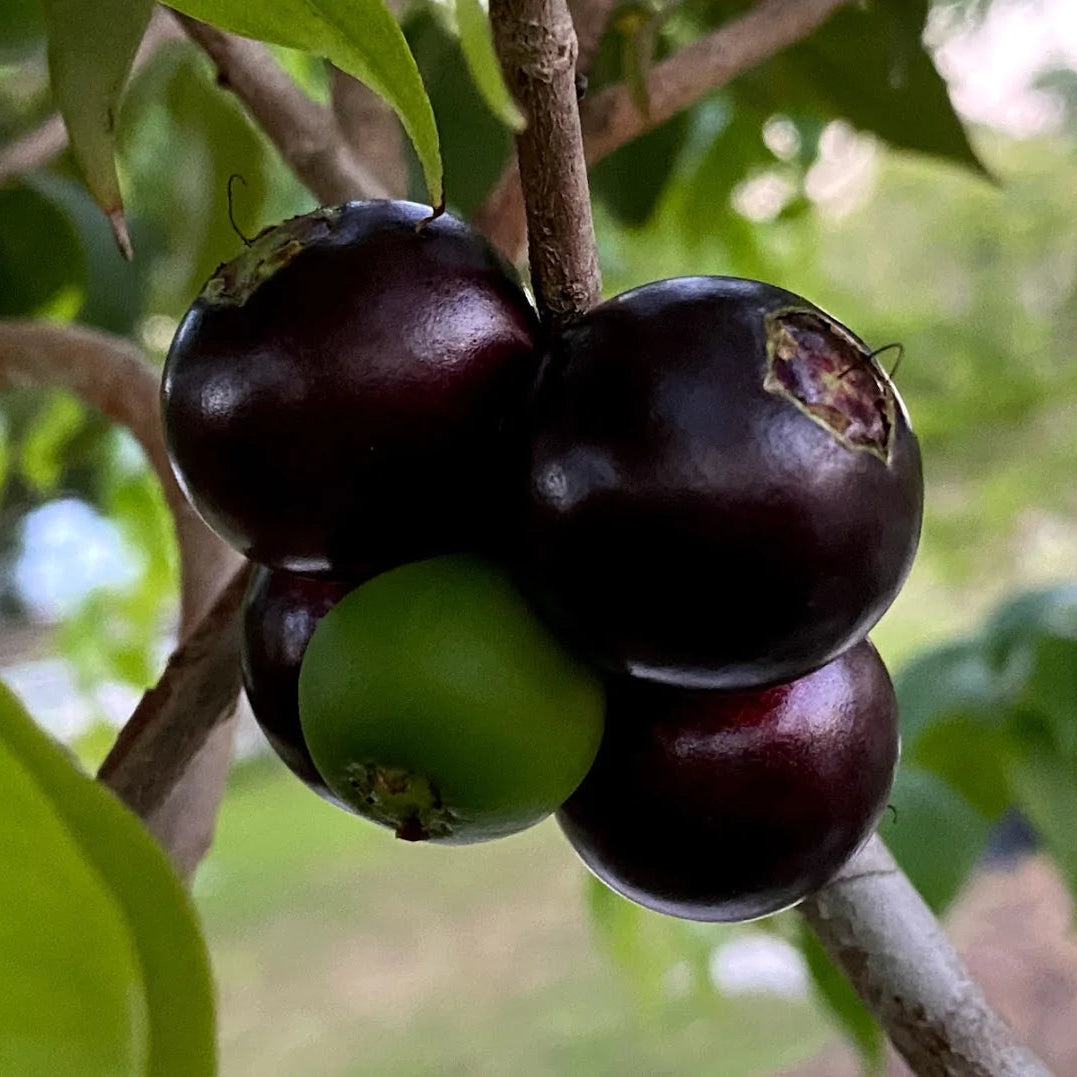Love it? Add to your wishlist
Your favorites, all in one place. Shop quickly and easily with the wishlist feature!
[message]
[title]
[message]



Veliyath Gardens
Couldn't load pickup availability
The Crowned Jaboticaba is one of those plants that immediately captures attention — not just for its beauty but also for its extraordinary fruiting habit and rich nutritional value. Belonging to the Myrtaceae family, this species is a rare Brazilian native cherished by collectors and exotic garden enthusiasts across the world.
Often compared to its cousin, the Sabara Jaboticaba, this variety sets itself apart with its distinctive crown-shaped sepal and refined flavor that hints at floral sweetness and root beer-like notes. With the right care, it becomes a showpiece tree and a prolific fruit bearer.
Botanical Name: Plinia coronata
Native Range: Brazil’s Atlantic Forest regions
Plant Family: Myrtaceae
The plant thrives in humid, warm zones where rainfall is steady and the soil is organically rich. Though still relatively unknown outside South America, this species is starting to trend among gardeners seeking something beyond the common guava, jamun, or cherry.
The Crowned Jaboticaba grows as a small tree or bushy ornamental, ideal for home orchards and space-conscious landscapes.
Growth Traits:
Mature Height: 3 to 6 meters in cultivated gardens
Canopy Shape: Rounded, dense, and symmetrical
Bark: Smooth, light brown to reddish, exfoliating with age
Fruiting Style: Cauliflorous — fruits are borne directly on the trunk and older branches
Its trunk studded with dark purple berries creates a dramatic and highly photogenic display during fruiting time.
What makes this plant so coveted is its fruit — both in appearance and taste.
Fruit Characteristics:
Color: Deep purple to near-black
Size: Medium, round, with a prominent calyx "crown"
Pulp: Juicy, pale, and plentiful (over 60% of the fruit)
Seeds: Small and few
The flavor is sweet, lightly aromatic, and often described as a mix of berry, floral candy, and mild spice. For children and fresh fruit lovers, it’s instantly appealing.
Fruiting Timeline:
Seed-Grown Trees: 6–7 years to fruit
Grafted or Mature Stock: 2–5 years with good care
Cropping Frequency: Multiple flushes per year in warm climates
Like many Myrtaceae fruits, the Crowned Jaboticaba is loaded with beneficial plant compounds.
Key Health Highlights:
Antioxidants: Helps combat oxidative stress and supports cell protection
Gut Health: Traditionally used to ease digestive discomfort
Respiratory Aid: Folk medicine recommends it for throat and breathing complaints
Anti-Inflammatory Support: Useful against chronic inflammation in the body
Bone and Tissue Health: Provides minerals that assist in bone strength
Skin and Hair Boost: Antioxidants and vitamins support repair and vitality
Its phytonutrient-rich skin may also play a role in promoting heart health and reducing toxin build-up.
In parts of Brazil, Crowned Jaboticaba has been eaten fresh from the tree for generations. Beyond snacking, it is also used in:
Homemade vinegars and wines
Fermented drinks and liqueurs
Thick jams and dessert toppings
Medicinal decoctions for coughs, swelling, and skin irritation
Its bark and fruit peel are sometimes dried or brewed in herbal recipes.
The fruit lends itself well to a wide range of preparations:
Fresh Eating: Straight from the trunk — the classic Jaboticaba experience
Beverages: Juices, spritzers, kombucha-style ferments, cocktails
Desserts: Sorbets, jellies, fruit leather, pie fillings
Cooking: Sauces for savory dishes or sweet reductions
Preserves: Jams, chutneys, and syrups
Because the pulp is soft and fiberless, it is easy to process and mix with other tropical fruits.
Though exotic, the Crowned Jaboticaba adapts well when basic care needs are met.
Climate Zones: Tropical and subtropical preferred
Temperature: Warm and humid; established trees can handle mild cold
Soil Type: Loamy, humus-rich, and well-drained
pH Range: Slightly acidic to neutral
Watering: Consistent moisture is key; avoid drought stress
Mulching: Helps regulate temperature and improve soil structure
Fertilizing: Organic compost and mild NPK fertilizers work best
Pruning: Light trimming improves air flow and encourages fruiting
Pests: Generally resistant; occasional monitoring is enough
It can also be grown in large containers when pruned and watered attentively.
Gardeners value this plant not only for fruit but also for beauty. Its ornamental trunk fruiting, evergreen leaves, and tidy form make it perfect for:
Tropical collections
Rare fruit gardens
Educational landscapes
Agroforestry projects
Decorative food forests
Urban courtyards and terraces (in large pots)
When in fruit, it naturally becomes the centerpiece of any garden.
The Crowned Jaboticaba is gaining momentum among plant collectors and exotic fruit growers because it is:
Visually stunning and unusual
Highly rewarding once mature
Packed with health benefits
Suitable for limited spaces
Valuable in tropical and subtropical climates
A conversation starter for any collection
Its rarity and ornamental-fruiting habit make it a worthy highlight in catalogs like Veliyath Gardens.
The Crowned Jaboticaba (Plinia coronata) is an exotic fruit plant that beautifully blends novelty, utility, and nutrition. Whether your goal is to cultivate something visually extraordinary, harvest antioxidant-rich fruit from your backyard, or expand a collection of rare Myrtaceae species, this plant delivers on every level.
Bring this elegant fruit tree into your landscape, and enjoy the rewards of a plant that is both rare and remarkably adaptable — a true crown jewel among exotic fruit plants.
Climate Zones: Tropical and subtropical preferred
Temperature: Warm and humid; established trees can handle mild cold
Soil Type: Loamy, humus-rich, and well-drained
Antioxidants: Helps combat oxidative stress and supports cell protection
Gut Health: Traditionally used to ease digestive discomfort
Respiratory Aid: Folk medicine recommends it for throat and breathing complaints
Anti-Inflammatory Support: Useful against chronic inflammation in the body
Visually stunning and unusual
Highly rewarding once mature
Packed with health benefits
Suitable for limited spaces




